Tuesday, October 31, 2006

Crossroads: Literature as Jazz
In cabin 579 on board the Cristoforo Colombo (see August 22 entry) in 1975, I had the ambition to read Finnegans Wake. I even brought a reader’s guide. My conclusion after struggling with Chapter 1 was:
”So much has happened since then (dylan, the great war, new worlds, new ways to speak, a new history and new associations) and his world* is so wound up in itself. A meaningless monument to the memory of a man. Of local interest to Irish with knowledge of latin and a liking for puns.
*) like the book”
Having arrived in Buenos Aires I immediately sent the books home.
At the Umeå Jazz Festival, the Swiss-Dutch singer Susanne Abbuehl made great renderings of Joyce’s and other’s texts. One of the most beautiful was from one of the last pages of Finnegans Wake:
“Sea, sea! Here, weir, reach, island, bridge. Where you meet I. The day. Remember! Why there that moment and us two only? I was but teen, a tiler's dot.”
Monday, October 30, 2006
 Desert Jazz
Desert JazzA favorite of the audience at Umeå Jazz Festival was Avishai Cohen trio. Three master instrumentalists (here two of them, Avishai and Mark Guiliana), playing so tight you could see the treads between them. They were the most generous group appearing at the festival, even having the surprised jazz audience sing along like it were a rock concert.
They played two evenings in a row, treating us with a newly written song both days, one of which was a beduins' chant.
Why was this music taken to the heart by the Swedes, in a way similar to the Norrland music I described earlier this month? Maybe because it is tied to the love of a landscape, the Israeli desert, like Johan's and Jonas' is to the northern rivers, forests and mountains.
They will now play in Uppsala, Lund and Stockholm - hurry and buy tickets!
Photo from http://www.avishaimusic.com/
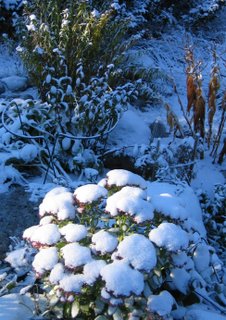 Suddenly winter
Suddenly winterNow only 2 weeks after my latest garden entry, temperature is several degrees below zero and snow covers the ground. From summer to winter in no time at all. The icy flowers appear taken by surprise by this instant change.
Tracks of hares, reconnoitering for winter food, are seen in the snow. The sun now hardly reaches over the treetops.
Tuesday, October 24, 2006

The surreal made real
An amazing performance is done by Aurélia Thierrée and Jaime Martinez in L'Oratorio d'Aurélia which is played here this week. It is the world turned upside-down and in-and-out. The show can be labeled as Cirque Noveau if you like, but there is no showing off of acrobatic talent even if it obviously is there.
Is it funny? The Swedish audience laughed a lot. However in Spain it was considered a sad story about loneliness (according to Aurélia)! Must be some difference in national character - we feel at home with the loneliness... But most of all it was very beautiful and a bit scary. Like wandering at night in a landscape painted by Magritte, Delvaux and Picasso, while Syd Barrett and Eric Satie are playing music somewhere.
It can only be compared to the shows made by Aurélias parents, Jean Baptiste Thierrée and Victoria Thierrée Chaplin - and Victoria has actually been creator, director, stage designer etc for this show.
This is a must if you have a chance to see it - L'Oratorio d'Aurélia will continue to tour Sweden until next week, and then France, Norway, and Switzerland in 2007.
Photo by Richard Haughton
Thursday, October 19, 2006
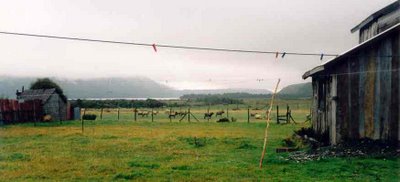
Darwin’s road to Cu-cow, 1835
On January 24, Darwin and his companions left Castro with fresh horses. “At Chonchi we struck across the island, following intricate winding paths, sometimes passing through magnificent forests, and sometimes through pretty cleared spots, abounding with corn and potato crops.” He found this a pleasing landscape, since it reminded him of the wilder parts of England… When he came to Huillinco, and Lago Cucao, the landscape changed again. “…. Only a few fields were cleared; and all the inhabitants appeared to be Indians. This lake is twelve miles long, and runs in an east and west direction.”
Like Chatwin 140 years later he travelled over the lake: “The road to Cucao was so very bad that we determined to embark in a periagua…a strange rough boat, but the crew were still stranger: I doubt if six uglier little men ever got into a boat together.”
He did not however (like Chatwin) travel with a corpse, but still with a strange passenger. “In the same periagua with us, a cow was embarked. To get so large an animal into a small boat appears at first a difficulty, but the Indians managed it in a minute. They brought the cow alongside the boat, which was heeled towards her; then placing two oars under her belly, with their ends resting on the gunwale, by the aid of these levers they fairly tumbled the poor beast, heels overhead, into the bottom of the boat, and then lashed her down with ropes. At Cucao we found an uninhabited hovel (which is the residence of the padre when he pays this Capella a visit), where, lighting a fire, we cooked our supper, and were very comfortable.”
The modern travellers came by bus, although the road was still quite bad. We stayed at the relatively comfortable and cosy Posada Cucao, probably the best hostel in the village. The back yard, with Lago Cucao behind, is seen in the picture. The chickens are seen first feeding in the front yard, then at dinner they appear on the table. The room was however feeling damp all the time and had a mouldy smell, reminding us that Chiloë is wet and rainy all year around.
Wednesday, October 18, 2006

Norrland – the Photos
Radio P1 sent a program about the photo collection at Västerbotten’s Museum. Sune Jonsson and Bertil Ekholtz. Also several less known female photographers, Albertina Eriksson and others, who travelled much and took pictures for people in the villages.
Again, I think about my Yttervik pictures. One has a quite good story behind it. Axel and Elsie were hosting a meeting of the board of the Same Ätnam cultural Association, of which he was the secretary. After the meeting, the Sami deacon Arvid Kaddik found that he had locked his keys inside the car. So the whole board was engaged in helping him to break into his own car, here Axel in the front of the picture.
Then I realize that this happened more than 30 years ago, and now can be classified as history. So I guess I should contact the museum and contribute my pictures to their collection…
Then they started to play some jazz music in the radio program. Guess what? One of the Norrland tunes by Johan Norberg and Jonas Knutsson, I don't remember which one, maybe “Yttervik”….
Tuesday, October 17, 2006

Norrland – the Music
I am a great fan of Johan Norberg (guitar) and Jonas Knutsson (saxophone), in particular when they play their “Norrland” collection, which now has been published in two CD volumes – “Norrland” (Gazell Records) and CowCow: Norrland II (ACT).
Johan’s in-between talk actually takes as much time as the music. His stories are so exhilarating they can be listened to any number of times. One of the favourites is when he tried to find Yttervik by driving on a dirt road using a colour slide of the village as the only guide. Only, he looked at the picture from the wrong side….
After hearing this, I tried to think: which, and where, were my own pictures from Yttervik? I stayed there some weeks as a guest of Axel Rydberg, the reindeer agronomist, and his wife Elsie.
I found lots of pictures of people, reindeer, and moose but strangely enough none of the house and yard. Or is it so surprising? The buildings and rooms are the things we take for granted, the framework of existence.
Monday, October 16, 2006

Late summer in the Archipelago
Probably the last warm days on the Northern islands - 13 degrees in daytime. Now we are waiting for the first snow.
Still, the lawn grows more than ever. The late-flowering plants keep flourishing - Chinese Spindle Tree (photo), Bugbane, pink Sedum, Colchicum, and many others. But maple shrubs and trees have turned yellow or red.
Sunday, October 15, 2006

Salty Cyclostomatan
Neither sour, nor fish, this is a local delicacy. Lamprey is in our area preferred smoked, and then fried in butter and stewed with cream. Best served with almond potatoes.
The river lamprey is a fishlike jawless animal which lives in the sea and migrates up in the rivers in the autumn, where it is caught in traps in a traditional manner.
When Linneaus described lamprey fishery in early 18th century it was already an old custom. It was taxed by the crown at least as far back as the 16th century.
Thursday, October 12, 2006
Lindqvist and Pirsig
Sven Lindqvist has been one of my literary heroes for decades. He seems to be, in all aspects, the total contrary to Chatwin as a travel writer – whether writing about South America or Australia. Politically and socially aware (but never dogmatic), respectful to the people that deserve it, trustworthy, and logically consistent.
I more or less followed in Lindqvist’s footsteps in South America after reading his classic travel reports which were published in two books in the 1970’s. I and my travel companion were not as ambitious in publishing as he was, so we only ended up with a series in the local newspaper. Without any payment.
In his new book, “Fadern, sonen och den heliga motorcykeln”, Lindqvist writes about his travelling (by car) in the motorcycle tracks of Robert Pirsig and actually meeting people who are in his book. The books of Pirsig have changed my ideas about things. I exactly remember where and when I was spending a night at a kitchen table, although it was quite long ago, not being able to put down “Zen and the art of motorcycle maintenance”. Lindqvist is however more critical than I was, at least at that time. Now I am just waiting for Sven to also make the boat trip which is the frame story in Lila…..
Wednesday, October 11, 2006
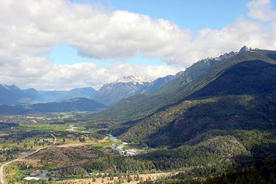
Patagonia 2007?
The other day I unexpectedly ran across a friend living in the other end of the world – Juan the Argentinian, who I haven’t seen for several years. Juan is now living in Bariloche, Patagonia. He was only in town for a couple of days and I was just leaving for the weekend. So unfortunately we had just a few minutes to chat.
Apart from some teaching and research at the university in Bariloche, Juan is now starting up a tourism company with his family and friends, outside Bariloche, at Puerto Manso, in Parque Nacional Nahuel Huapí. The concept, lodging and surroundings look promising enough. Maybe this will be the target for the next trip to Patagonia…
http://www.puertomanso.com/
Monday, October 09, 2006

Matthewism. Lindqvist, Wallace and Darwin
In his latest collection of essays, “Fadern, sonen och den heliga motorcykeln” (2006), Sven Lindqvist writes about Charles Darwin’s famous stomach problems. He contends that it was no wonder that Darwin vomited in the mornings, considering the terrible secret he was carrying for several decades, until Alfred Russell Wallace (photo) forced him to “come out of the closet” with evolution by natural selection.
Actually Wallace is often placed in the shadow of Darwin, which is somewhat unlucky. He had stated the theory of evoultion by natural selection just as good as or even somewhat better than Darwin. He had suffered more than Darwin in his travels, almost dying in fever and being shipwrecked and losing all his natural collections and notes. He is one of the true heroes of the development of biological science.
As Lindqvist points out, the first person to come up with the theory of natural selection, three decades earlier, was actually neither Darwin nor Wallace, but Patrick Matthew. Matthew was an author of a book of ship timber, and thought natural selection was quite self-evident and nothing to make a big affair out of, so he put the theory in a foot note. So evolution by natural selection might just as well have been called Matthewism.
Thursday, October 05, 2006
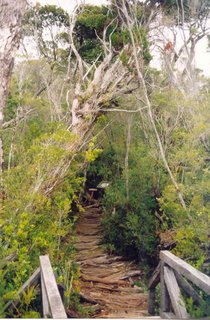 The road to Chiloë, 1835
The road to Chiloë, 1835The 25 year old adventurer Charles Darwin passed Chiloë (and the Chonos) on his travels with the “Beagle”, in the southern summer of 1834-1835. He spent some time in November – February on Isla Grande, Lemuy and other islands. He found Chiloë a troublesome but fascinating place. It was terribly rainy, the forest impenetrable and impossible to clear by burning. The people were incredibly poor, although very friendly and helpful.
Charles visited many of the places we did. Strangely enough it is easy to recognize today’s Chiloë in his writings, for example the openness and friendliness to strangers: “Everyone on this road acts on a ‘hail fellow well met fashion’ and one may here enjoy the privilege, so rare in South America, of travelling without firearms.”
He was riding from Ancud via Castro and Chonchi to Cucao and tells of the dangerous roads. “Even where paths exist, they are scarcely passable from the soft and swampy state of the soil.” Some roads were made by logs but they were very wet and slippery. He wondered at the strange manners of women, very unlike that of fine English girls: “Our female companion, who was rather good-looking, belonged to one of the most respectable families in Castro: she rode, however, astride, and without shoes and stockings”.
Tuesday, October 03, 2006
 What is in a brand?
What is in a brand?On SVT2 there was a program today about the community of Gustavsberg. This is famous for fine architecture in the small and medium format. It is above all known for industry of porcelain and other ceramics, with many excellent designers and artists, such as Stig Lindberg and Karin Björquist. The photo shows a piece from her series "Kobolt".
Today the big factory is closed but there is still a lot of small scale activity related to ceramics and handicraft. At the same time, there are plans for establishing Gustavsberg as a conference centre with an 80 store hotel.
Will it be possible for this new "Gustavsberg Harbour" to benefit by using the goodwill of the old trademark, one of Sweden's best known, without ruining what created it?
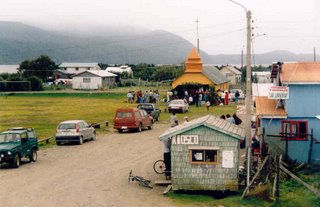
The road to Chiloë, 1975
When Bruce Chatwin came to Chiloë, he travelled west toward the Pacific Coast. At that time there was no road to Cucao so from Huillinco people took the ferry over Lago Cucao. He had to travel with the coffin of a dead woman and felt like he was on the river Styx.
Of course he picked up some stories in Cucao, about the witchmaster Millalobo and a baby partly changed into a seal…and about the landing place of the Ferryman (whom you should not call for). This is all in the chapter “Chiloé” in the essay collection “What am I doing here?” He mentions two wooden churches, standing in a field, which could have been built by old celtic monks.
Sunday, October 01, 2006
 Gardens of Wij 2 - the Gates
Gardens of Wij 2 - the GatesThe gardens are a fantastic creative setting. There are many surprises. One of these were the gates made by smithery design students of HDK Steneby . The photo shows a detail of one of these, made by Gustav Karlsson.